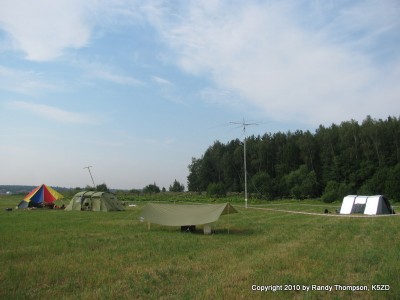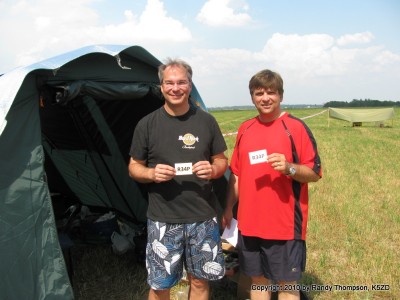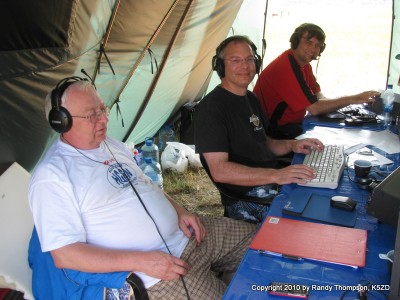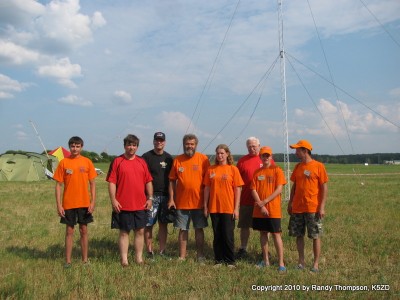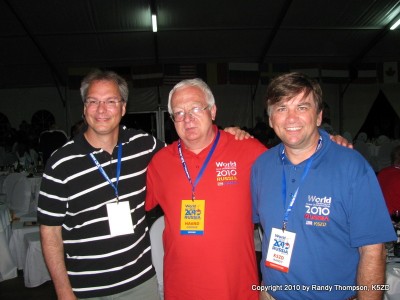WRTC 2010 Moscow
Written by Tom Georgens, W2SC (Tom.Georgens@netapp.com)
Photos by Randy Thompson, K5ZD
The Plan
The first thoughts of WRTC 2010 began at the closing ceremony in Florianopolis Brazil in 2006. After stating several times that this would be his last WRTC, Randy said he was up for doing this one more time. We were disappointed in our performance in many respects, and we both were convinced that we could do better than our 10th place finish. A bunch of clear drinks with green leaves at the bottom may have influenced our decision as well.
When the qualification criteria was announced, it was not going to be possible for me to qualify without doing a number of high point contests from my home area of California. The idea of trading off several of my favorite contests from Barbados to operate one WRTC was not very appealing. Randy was clearly building the points to qualify, but I was not certain he really intended to participate again or whether that was just the alcohol talking one late night in Brazil. Once he reiterated the plan, I could return to my normal operating schedule from Barbados.
Preparations
We were both very busy and spent very little time preparing. We touched base in March, before my last trip to 8P prior to WRTC to be sure that I brought back any necessary gear. I would bring my two K3’s, power supplies, Dunestar filters, master control box and a myriad of small items and cables. We agreed that we would get together on the WPX CW contest weekend to assemble the station and work on our operating strategy with the new rules.
We spent some time talking about the implementation of the lockout. I had also seen some sample designs on the reflectors that used the TX INH functionality of the K3, but I did not like how they worked. Instead I went ahead with a different approach and I designed a custom box with a small processor inside.
The next issue was the triplexer. I had never seen of such a device, yet I was hearing that it was a common item in this type of competition. In doing some research on the web, I found a reference to a Field Day team that used one successfully to share a tribander. I was very intrigued, but there was no design data. However, in the course of the search, I found that QST was about to publish an article on this design. When the article came out, I was embarrassed that I did not think of the simple concept myself. Since time was of the essence, I ordered the identical parts and had a unit built a week later.
The testing of the unit was a total surprise. Using the decoupling head as described in QST and my switchable bandpass filters, I could share a dummy load without any hint of interaction, with the exception of the 20 meter harmonic on 10 meters. While the isolation was good, the impedance match was not great and I did not have much time to work on it before traveling cross country to Randy’s for our test session.
I did the redeye flight arriving Saturday morning and we immediately started setting up when I arrived. We decided to use my station automation from Barbados to do the filter and antenna selection as well as the keyer function. It required making some custom cabling to connect to Randy’s W3NQN filters and 6-pack. We also had to get the audio recording solution to work as well. We decided to use a third computer to record and the referee could use the mixer controls to adjust the levels of what he heard in each ear. This should give enough flexibility to handle any scenario. Overall, we spent more time that weekend working on audio issues than anything else.
With the station fully assembled, we began testing in earnest. This was the first real test of the triplexer and the isolation was as good as I saw at home. It was also good to use it for an extended period to test the components. However, the SWR through the decoupler was still not what I wanted.
Overall, the station worked fine, but there were some more switching options we wanted to add to the control box and we wanted to change the functionality of the lockout box. Both would require some programming in the interim
In the intervening period before WRTC, I did reprogram the lockout and control boxes and got them all retested. I also spent a lot of time with the triplexer, including an alternative implementation. I could not improve the SWR on the existing box and confined my experimentation to the second unit, knowing I had a usable baseline in the box we originally tested. I eventually understood the design tradeoffs the author had made, and wished I had just a little more time to optimize the outcome. In the end, I had a unit with a better match, lower loss, and slightly less isolation. However, it used more fragile components than the original design and had never been tested over an extended period.
Also, in the mean time, I had the 15 meter section of my Dunestar fail. I ordered a replacement, since I wanted a new one for Barbados anyway, and Ron sent me some replacement caps for the 15 meter section. The repaired Dunestar looked good, and we now had a backup set of band pass filters.
While I was working on the triplexer and lockout boxes, we ordered a pair of LDG automatic antenna tuners. Randy tested these in various combinations. One of our concerns was the sensitivity of the power monitoring device and we wanted the option of putting the ATU after the monitor to avoid any issues with SWR. In the end we decided to install the ATU’s in the 40 meter and 80 meter feedlines so we could move around the bands without returning, and we could also use these antennas on the high bands, if necessary.
Trip
I had been exceptionally busy at work and simply could not keep up with the complexity of the hotel, VISA’s, tours, applications, etc. . None of this would have come together without the help of my executive assistant at work. She not only followed up on every item for me, she also took care of my wife Kathleen and son Alex who would be going with me.
Every step of the way was on a tight schedule, including the arrival of my passport with the Russian visa the day before I was to leave for Europe on a business trip. We also wanted to extend our trip to visit St Petersburg after the WRTC weekend. Eventually all the plans came together, but some of the tourist options were not resolved until we were in Russia.
The trip was finally upon us. Alex and Kathleen spend the summer in Maine so they left the week before I did. I flew all day on Thursday 6/31 to Randy’s house in Massachusetts for one last check out of the station. We wanted to validate the new lockout and control box software as well as get some run time on the triplexer. I also wanted to get a feel for how the antenna tuners worked.
I was to arrive late in the evening at Randy’s, but flight delays made me even later. Around 2AM, I arrived at his QTH and we immediately started to set up. Things were going OK until we could no longer match the 40 meter dipole on 15 with the ATU. As it turns out, we blew out the 15 meter section of his W3NQN filters. Randy had another NQN filter set that had a couple of bad sections s well. Our plan was take parts out of the 15 meter section of the old filter to replace the ones in the newer unit. Unfortunately, there were no obviously damaged components so we used the smell test to guess which ones to try. Although the process was not pretty, we eventually substituted six caps and the filter now worked OK.
Once we had everything working again. We did a final checkout of the station. In the process, it seemed like the triplexer isolation was better with two dunestars than with one Dunestar and one NQN filter. We decided to go with the dual Dunestar configuration with the NQN as a spare. We also chose to go with the new triplexer design, despite the lack of run-time.
We then spent the rest of our time contemplating what we would do in the event of failures of individual components. If the Control Box failed, we would need two keyers, filter selection, and antenna selection. We chose to bring two spare W5XD keyers and build another manual switch for the Dunestar filters (I already had one). For the 6 pack selection, we would bring the manual switch and wire it in if necessary. For a lockout box contingency, I would build a version of the cable documented on the reflector that used TX INH. We piled up a bunch of spare cables and were all set. We had nearly enough backup hardware to operate a second WRTC station.
Around noon, after being up all night, I left for Maine to join Kathleen and Alex. In addition, my daughters were coming up with friends for the holiday weekend. Over the weekend, I made a trip to Radio Shack and gather parts to build the last items. They came together, but it was a challenge in a tool-limited environment.
All seemed well, until Sunday night. I happened to turn on my computer to print a file, and the screen never came on. I connected it up to a monitor and it seemed to be working, so possibly just the screen had failed. However, it also had an unexpected message about new USB devices found. While there would be monitors provided at the contest site, I could not be sure that it was the only problem. Out of desperation, I called my admin in California and asked her to send me another computer from my house. My plan was to have it shipped to our DC office, and I would pick it up during my 5 hour layover at Dulles airport. After a few false starts, the plan came together.
On Monday night, Kathleen, Alex and I, along with six suitcases, drove down to Logan airport in Boston to stay overnight for our morning flight. Our first flight to Dulles was without incident. Instead of driving out to the DC office, they took the PC that was shipped, and took another of the same model they had around the office and brought them to me. It was a huge relief to have options in the event of more PC trouble. We then took off for a long, but pleasant, trip to Moscow.
Event
We arrived in Moscow late morning, had an uneventful pass through customs and we were off to the hotel. A few of the competitors were already there and we renewed some old acquaintances in the lobby while we checked in. The room was very nice. It had a small separate room for Alex and a very effective air conditioner. The local broadband Internet was very slow (and expensive for me) but they had wired service that worked just fine.
In an attempt to acclimate to the time change, Kathleen and I tried not to sleep right away. Instead, we went on a walk around the hotel grounds. We saw the “beach,” the “ship,” and the Scandanavian Hall. We also saw one of the ground teams assembling a sample station at the hotel. The tower was on the ground and they were just installing the dipoles and feedlines. The tower was so thin that I could not fit my foot on a rung between the corner pipes.
After our walk, I set up the station in our room. I had all of the control gear and cables along with the filters. I would be able to test the computers, radios, power supplies, lock out box, keyer, filter selection and antenna selection. It all came together quickly and it looked like all the gear survived the trip. Once complete, we had a brief dinner and went to bed.
The next day, my company’s representatives in Moscow arranged a tour of the city. It was an intense all day tour in extreme heat. It was very enjoyable, but exhausting. K1VR said I looked wiped out when I returned.
It was now Thursday night and most of the competitors and referees had gathered. It was great to see people that I had never met before, or had last seen in Brazil. There was a lot of probing among the teams with regard to strategy and equipment. The new technologies this year were the triplexers and the lockout schemes. In general, the conversations were honest, but circumspect. Most teams were not completely willing to disclose the full extent of their thinking. More broadly, while everybody was friendly and pleasant, there was an overarching tension and anxiety about the competition that I did not recall in Brazil. It seemed to me that late nights and heavy drinking were not as prevalent as last time.
The tension and intrigue grew on Friday with the opening ceremony, station draws and the competitor/referee meetings. The opening ceremony was very hot but it was organized and serious. The draw was also well run. We all had maps of the stations and created our own preferences when, in fact, it did not matter. The stations were essentially identical and relatively close to the hotel (unlike our 300kM drive in Brazil). Our only wish was to be far from any civilization. We ended up with a station that looked as good as any other, our only concern was that we had another station very close by. We also were privileged to have HA6ND as our referee. We had fun with George all weekend. We also met the unsung hero of the weekend, RU3BH. Vladimir, along with his family and another couple, set up and maintained the station, as well as giving us great support all weekend, despite his limited English (and our non-existent Russian)
The competitors meeting was relatively calm with a few contentious issues around recordings and Russian language operation. The bigger issue was the rule that the station you work must copy the call and exchange correctly for you to get credit. There was a fair amount of passion around this point but the judging committee did not yield. For the record, we lost three times as many Q’s due to copying errors by others than we lost due to our copying errors.
While in the meeting, Randy and discussed the station setup. We were to get to the station around 7AM but the contest did not start until 4PM. If we had issues, we would appreciate the time but, if things went well, it would be a long time in the hot sun waiting for the contest to start. We decided to arrange for transportation back to the hotel in the event the station was ready with plenty of time to spare.
After the meetings we had a very subdued dinner that broke up early. Clearly people were getting their game faces on.
Contest
Between the time changes, preparation issues, and pre-contest anxiety I had been having a very difficult time sleeping. I had set the alarm for 5AM and tried to get as calm as possible. I fell asleep quickly but eventually woke up. I looked at the phone by the bed and it said 4:40. I was very pleased that I had slept so well. When 5 o clock rolled around and the alarm did not go off, I realized it was my son’s phone and it was still on US time. The actual time was really 1 AM and I had not really slept much at all. Most of the rest of the time was tossing and turning, waiting for 5 AM to arrive. One thing that was different was that it was not the normal anxiety, it was more of excitement. I was not nervous anymore, I was eager for the event to start. Based on conversations with the other players, I felt we had engineered enough station capability to be competitive, and we were ready.
Our driver took us out to our station at 6:30 AM. Besides the normal setup, I was worried about three specific items, antenna interaction, generator noise, and RF in the tent. The station was exactly as advertised and RU3BH and team were ready for us. They took fantastic care of us all weekend. They also seemed to perfectly position the tent to allow the breeze to pass directly through. Although very humid, the tent was very pleasant inside.
Before we oriented the tables, I wanted the generator started so I could hear how loud it would be. As it turns out, the generator was barely audible in the tent. Our plan was to put the three tables in a line with the pelican case behind the middle table. This would give me something to sit on while I assembled the station, and it would be a platform to hold the RF parts (triplexer, filters, and six pack)
Everything was going OK, when I made a huge mistake. I was sitting behind the table connecting cables (all of which were labeled) and handing ends to Randy to plug in. I thought I was done when I had a cable left over that said “+12V” on it. I thought I had handed Randy a cable to connect to power. It turns out that I had, and the other end was plugged into a signal input on the lockout box. Not good. I then put the cables in the right place, but the lockout box did not work correctly. The signal input goes directly to the microprocessor, and I had just burned out an input with the 12V. I have a very low resting heart rate, but it was now sky high. I tried to calm myself to consider options. I had the schematics with me and frantically searched for a solution. Restoring full functionality would require a soldering iron and the ability to reprogram the processor. I still had the cable for use with TX INH, but I did not want to use it since we never practiced with that functionality.
Trying to contain my emotion, I went into my spares box to get my programming cable. Looking through the box, it occurred to me that I had brought a spare microprocessor. If the programming worked, I may be able to recover. I connected the cable to the existing processor and it communicated just fine. I popped the other processor out of the socket and put the new one in. The program loaded just fine. There was one more step in that we made a design change since the original implementation and I needed to solder a wire to pin one of the chip. We could live without this, but we would lose a little functionality. It turns out that RU3BH had a soldering iron and I was able to tack the wire on, despite shaky and sweaty hands. The wire was on and we were back in business, although I had just burned off a lot of nervous energy.
The rest of the set up was entirely uneventful. I used the LCD monitor with my PC with the bad screen and it worked fine all weekend. Randy dealt with the power monitors and the score reporting software with George, our referee. We played around with the power monitor and it was not the ordeal I had anticipated. Randy and George had some occasional words about the indicator during the contest, but it was mostly a non-issue.
Randy also tuned up the ATU units so we would not need to touch the antennas. We did an overall test of antenna interaction and it was non-existent. We also had no RF in the tent despite the fact that the 80 meter inverted Vee was staked about 5 feet from the radios. The triplexer isolation looked good and we started to make a few Q’s. I had a quick pileup and the bands sounded good. We could hear numerous other WRTC stations warming up, including our nearest neighbors. Signals were a full 60dB over nine but, with one exception, the close by stations had clean signals and were not a problem all weekend.
It was some time after 10:30 and we started thinking about returning to the hotel. The station seemed ready and we would just burn nervous energy in the extreme heat waiting for the contest to start. Instead we would return to the hotel, get some rest, get cool and eat. The plan was to leave the hotel at 2PM.
I returned to the room took a shower and tried to rest for about 90 minutes before having lunch. There were a number of other competitors back at the restaurant as well. Some were close enough to walk, others had referees with cars. We left to go back to the station and the traffic was remarkably heavy. We did not get back until around 2:30. There was a last test I wanted to run that I forgot in the morning. I wanted to test path loss through the switching by using my Elecraft signal generator at the tribander port to make sure there was no unexpected loss in the system. It looked fine. After adjusting microphone audio some more, we were ready to go. In honor of our Hungarian judge, I put on my Hard Rock Caf? – Budapest shirt.
About 15 minutes before the start we were to turn off the radio audio and an open our callsign envelope. We drew R34P. Randy was not at all happy about the “P” at the end. My concern was the “4” in the double number call. We decided that I would start on 20 CW and Randy would work the other bands. After a little discussion, we chose to go for 14001.
The bell rang and we were off. I was able to hold 14001 but I had K0DXC on the other end of the circuit. I did not know he was operating from K1LZ but I figured people would be beaming our way to work the WRTC stations. The rate was a pleasant surprise and it would continue all weekend. The way we started remained the pattern all weekend. I was mostly running while Randy was frantically combing for mults and Q’s. We tried alternating CQ’s all weekend but they were only effective when the rates were slow. As soon as one operator had rate, it was more productive for the other op to S&P. Generally, the S&P op had priority and could interrupt the running op any time he wanted.
Several hours into the competition, the sky began to darken and serious winds began to blow. It was clear that there were electrical storms in the areas as we could hear the static building in the radios. When static levels were over S9, rates dropped and we needed to start thinking about shutting down. Fortunately, we were never faced with that decision. Our QTH had very high winds, but others had torrential rain and hail. One station had a lightning strike about 50 feet from their tent. After an hour, the sky cleared but it was tense while it lasted.
Twenty eventually gave way to the low bands. The excellent rate continued through some excellent hours on 40 and 80. With daylight lasting until around 11PM, there were limited hours of darkness and the bands stayed productive. It seemed like one or both of us could generate rate somewhere all weekend.
Before the contest, I did not think anyone would get to 3000 Q’s, but we passed that with many hours to go. I started to think about 4M points and 3500 Q’s. After passing 3500 Q’s with nearly an hour to go, we pushed for 3600 and 4M. It was going to take a bunch of mults to get to 4M but Randy kept finding new ones. Finally XU7ACY called in, putting us over the 4M mark, but we fell 3 short of the 3600.
When 1200Z rolled around it was time to stop. We had no idea where we stood, but it seemed like we did well. It was hard to tell since, every other station had the same openings we did, the question was whether we missed any. Time would tell.
No matter what the outcome we worked as hard as we could. On top of that, all the custom gear worked exactly as advertised, and without incident. At no time in the course of the weekend did we ever even suspect a problem. I remember thinking that we tried our best and the station performed flawlessly. There were no excuses, any team that beat us did so because they did the better job. I can think of no higher praise for the competition organizers. This was arguably the best radio competition ever held.
Aftermath
We more or less jammed everything back in the bags for the ride home. We gathered out by the tower for final pictures and goodbyes. We were told that the station builders may want our help to take down the tower. We offered, but RU3BH was fine with doing it with the team that put it up. There was heavy traffic and it took about 30 minutes to get home. After unloading the car, I went up to the room to take a first look at the scores. Admittedly, I was expecting a finish better than 5th. I suspect, with QSO totals so high, many of the other stations had similar reactions. Before the contest, we would have been more than happy to finish 5th, but we could not avoid the “what if’s”
The teams convened for dinner. Most operators had nothing but praise for the conditions and the stations themselves. Clearly this was a draining event as dinner was subdued and broke up early. I went back to the room expecting to watch the World Cup final. As soon as I hit the bed, I knew it was not to be and I was asleep before kickoff.
The next morning we went on a large group tour of Moscow. It was great to share war stories with the other competitors. Some of the stories were not so pleasant, like the OE team that lost both radios. There was a lot of discussion of lockout strategies with teams that tried dual CQ’s all weekend and those like us that had one running and one searching. Another area of wide variance was the amount of SSB QSO’s. Among the top teams were those with the most and least percent of SSB Q’s. It seemed that there was no firm winning strategy.
After a long hot day, we were back for the closing ceremonies. There was some jostling at the top and the N6MJ/KL9A team slipped into the top three and the RW1AC/RA1AIP securing a very close, but well deserved victory.
With the scores in the book and much more pleased with our effort than in Brazil four years earlier, it was time to speak about next time. Both Randy and I said beforehand that we would never do another WRTC. I told Randy my mind had changed somewhat. I would never do another traditional WRTC where station selection was critical to the outcome. However, I would do another event like this in a minute. The Russians raised the bar, and it is critical that WRTC embrace this format. Otherwise, it may become more of an exhibition and irrelevant as a competition.
We all stayed up reasonably late and said our goodbyes. The passion for the sport and appreciation for what the organizers had done made for an emotional evening. It was my distinct honor and pleasure to have participated in the most compelling event of my Radiosport career. Words cannot express my appreciation to the Russian team for putting this competition together. It was an extraordinary experience I will never forget.

